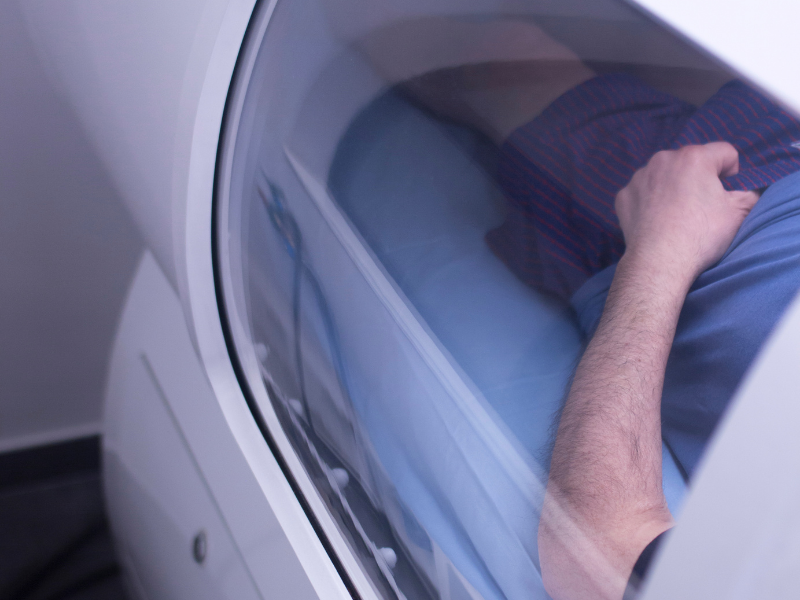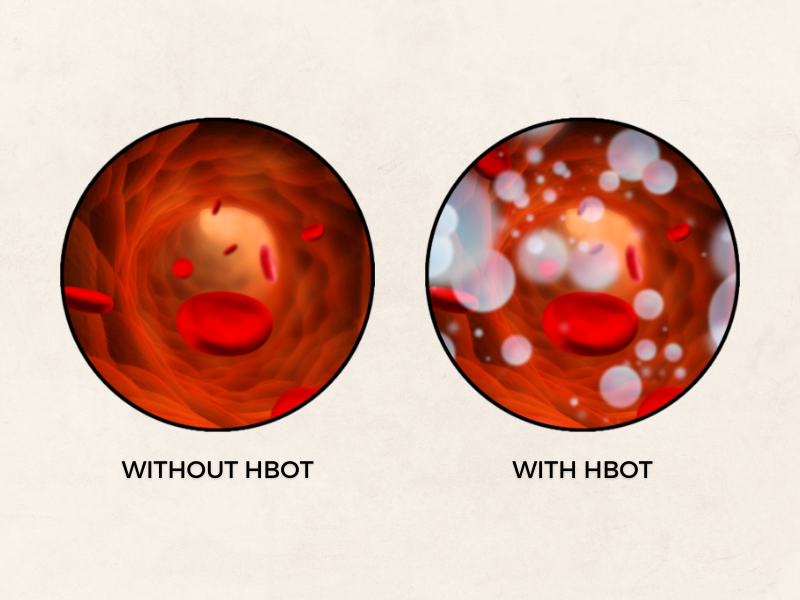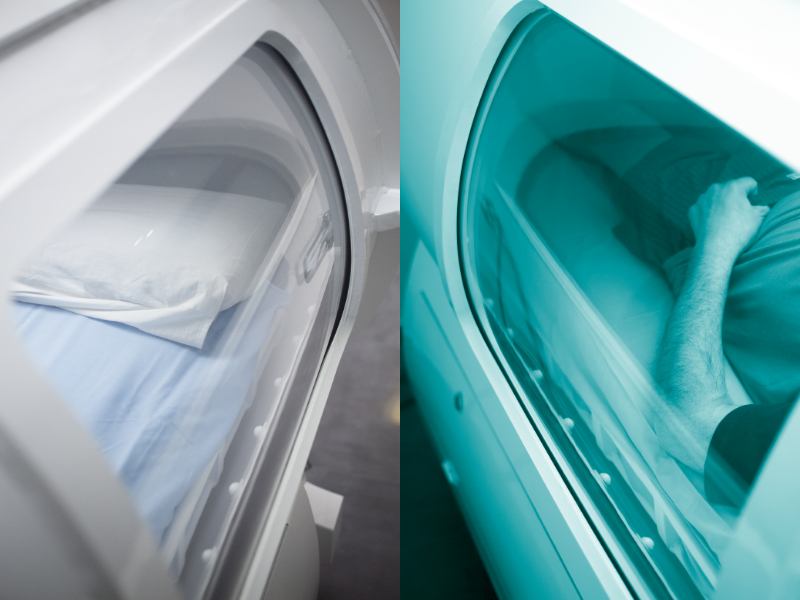Take a deep breath.
Now imagine if that simple action could supercharge your body's natural healing abilities. That's the immense power of hyperbaric oxygen therapy. This treatment literally breathes new life into the body's regenerative powers.
Hyperbaric chambers allow patients to experience an increased air pressure, delivering a mega-dose of oxygen to tissues in need.
The results can be remarkable - restoring circulation, fighting infection, and kickstarting the healing process.
From stubborn wounds to traumatic injuries, hyperbaric oxygen therapy provides a highly effective solution when the body needs an extra boost to overcome damage.
This regenerative treatment has been proven through decades of use and extensive research. However, hyperbaric chambers were once only found in hospitals and clinics. Now, with advancements in technology, these healers can be purchased for convenient at-home use.
Keep reading to learn all about the benefits of hyperbaric oxygen therapy and how you can bring this powerful treatment into your own home. Breathing deeply has never felt so good!
What is Hyperbaric Oxygen Therapy?

Hyperbaric oxygen therapy (HBOT) administers oxygen to patients inside a sealed chamber at pressures higher than standard air pressure. This therapy is used to increase the amount of oxygen in the body's tissues, which can promote healing and provide various therapeutic benefits.
HBOT can be used to treat several medical conditions, and it is most commonly used for decompression sickness in divers, non-healing wounds, certain infections, and other medical issues where increased oxygen levels can aid in recovery.
How HBOT Works

Hyperbaric oxygen therapy works by exposing a patient to oxygen in a pressurized chamber, typically at pressures up to three times greater than normal air pressure. Under these conditions, the body absorbs a significantly higher concentration of oxygen, which dissolves into the bloodstream and gets delivered to tissues throughout the body.
This heightened oxygen supply serves to improve the delivery of oxygen to tissues that have been damaged or compromised, resulting in more effective healing. In addition, it contributes to the reduction of inflammation, fosters the growth of new blood vessels through a process called angiogenesis, and supports the body's inherent mechanisms for healing. Notably, in certain situations, hyperbaric oxygen therapy can even assist in combatting specific infections, as bacteria often find it challenging to thrive in an environment saturated with high levels of oxygen.
Overall, HBOT activates the body's natural healing processes by supplying more oxygen under pressure, which can help treat tough medical conditions.
Conditions Treated with HBOT
HBOT has been used to effectively treat a variety of medical conditions, including:
-
Decompression sickness: Also known as the bends, decompression sickness occurs in divers when nitrogen bubbles form in the bloodstream. HBOT reduces bubble size and helps eliminate nitrogen from the body.
-
Carbon monoxide poisoning: HBOT accelerates switching carbon monoxide with oxygen in the blood for carbon monoxide poisoning cases.
-
Non-healing wounds: Diabetic ulcers, chronic wounds, or injuries that have failed to heal with normal medical care may improve with HBOT.
-
Radiation injuries: By improving blood flow and oxygen delivery, HBOT shows promise in treating radiation injuries.
-
Crush injuries and acute traumatic ischemia: Restoring oxygen delivery is crucial for these injuries, making HBOT a useful addition to standard medical care.
-
Compromised skin grafts or flaps: HBOT improves the chance of graft and flap survival in compromised tissues by stimulating angiogenesis and fighting infection.
-
Gas gangrene: HBOT stops the growth of gas gangrene bacteria and the toxins they produce.
-
Severe anemia: HBOT may reduce the number of blood transfusions required in patients with severe anemia.
HBOT is a treatment option for various conditions, particularly non-healing wounds, radiation injuries, gas gangrene, and decompression sickness, by supporting the body's natural healing process.
Research on HBOT

HBOT has been studied extensively, and research demonstrates its benefits for various medical conditions. Here we'll explore some key studies on the positive impacts of HBOT.
Improving Quality Of Life For Breast Cancer-Related Lymphedema
A study looked at 19 women with lymphedema after breast cancer treatment. They were given 40 HBOT sessions over 2 months. Six months later, they reported significant improvements in quality of life, including physical functioning, fatigue, insomnia, and arm/breast symptoms. The benefits peaked at the 6-month follow-up.
Boosting Immunity and Natural Killer Cells
A randomized trial in 16 healthy women found that mild HBOT effectively increased natural killer cells, important immune cells targeting cancer. This demonstrates the immune-boosting potential of HBOT.
Benefits of HBOT for PTSD in Veterans
Research has shown HBOT to improve symptoms of PTSD in veterans resistant to other treatments. In one study, 22 veterans with PTSD received HBOT. Follow-up 1+ years later revealed clinical improvements in PTSD symptoms and quality of life.
Helping With Perioperative Peripheral Nerve Injury
A literature review found HBOT beneficial for 88% of human and animal studies on peripheral nerve injury from surgery/anesthesia. HBOT improved nerve regeneration and recovery time without major side effects.
In summary, studies demonstrate HBOT can improve outcomes for conditions like lymphedema, PTSD, nerve injury, wound healing, and immunity. More research is underway to expand evidence on the benefits of HBOT.
HBOT Treatment Process

The HBOT treatment process involves breathing pure oxygen inside a specially designed chamber. The hyperbaric chamber raises the air pressure to 1.3-3 times above normal atmospheric pressure. This allows your lungs to take in more oxygen than breathing normal air.
Before starting HBOT, you'll remove any clothing with heat-generating fibers or petroleum products. You'll wear cotton scrubs or a hospital-approved gown. During treatment, you can sit or lie down comfortably inside the chamber. Some chambers can also accommodate a wheelchair.
As the air pressure rises, you may feel pressure or fullness in your ears, similar to being on an airplane. You can relieve this by yawning or swallowing. Depending on where you're doing your treatment, the staff may monitor you through a window and communicate via an intercom.
Most sessions last about 45-60 minutes. You can watch TV, listen to music, or just relax. After treatment, the air pressure is slowly returned to normal, and the staff will then check your blood pressure, pulse, and blood sugar if needed.
Purchasing an HBOT Chamber from Airpuria

As an authorized dealer, Airpuria offers high-quality hyperbaric oxygen chambers from one of the top manufacturers of HBOT chambers - OxyHealth. Their chambers are FDA-approved and provide safe, effective HBOT in a comfortable environment.
Airpuria's HBOT experts can help you select the right chamber based on your needs. We also offer financing options to help make purchasing a chamber more affordable.
Before buying an HBOT chamber, you'll need a prescription from your doctor. Airpuria can connect you with a licensed physician if you don't already have one.
In addition, it's important to note that most insurance companies do not typically cover HBOT treatments, which is why purchasing a home HBOT system is particularly beneficial. However, we strongly recommend that readers contact their insurance company directly for additional information and to inquire about any potential coverage options or changes in policy.
Contact the Airpuria team to learn more about purchasing a hyperbaric oxygen chamber for home use. Our knowledgeable staff is ready to answer your questions and get you started with HBOT.
See OxyHealth Hyperbaric Chamber Options
Financing Options for an HBOT Chamber
Purchasing a hyperbaric oxygen chamber is a significant investment in your health and well-being. Airpuria offers financing options to help make owning an HBOT chamber more affordable.
Airpuria partners with trusted financial institutions to provide flexible financing solutions. Based on your credit, you may qualify for low or zero-interest financing.
Learn more here:
-
Financing for individuals: https://www.7figures.app/Airpuria
-
Financing for businesses: https://reliantcapitalgrp.com/airpuria
Contact Airpuria for More Information

The team at Airpuria is ready to answer any questions you have about hyperbaric oxygen chambers and financing options. Reach out by:
-
Calling 773-337-8822 to speak with an HBOT specialist
-
Using the chat feature on our website
-
Emailing sales@airpuria.com
Before purchasing, customers must provide a valid prescription or doctor's note to buy an OxyHealth Hyperbaric Oxygen Chamber from our company. You have two options for submitting this required documentation - upload the file through our online order system or email it directly to sales@airpuria.com. Please send your doctor's note within 2 weeks of placing your order. For any questions or to consult with one of our licensed medical professionals, contact our Airpuria team for help.
Our experts can provide guidance on selecting the right chamber, obtaining a prescription, financing, and any other aspects of hyperbaric oxygen therapy.
Whether you're exploring HBOT for the first time or ready to purchase, our staff is here to help. Our goal is to make HBOT easy to understand and accessible through excellent service.
HBOT FAQs
What is the hyperbaric chamber good for?
Hyperbaric oxygen therapy (HBOT) has been proven effective for treating a variety of medical conditions that benefit from increased oxygen delivery. Approved uses of HBOT include:
-
Non-healing wounds, ulcers, and burns
-
Crush injuries and compartment syndrome
-
Decompression sickness in divers
-
Carbon monoxide poisoning
-
Radiation tissue damage
-
Skin grafts and flaps at risk of tissue death
-
Acute traumatic brain injury
-
Diabetic wounds
-
Gas gangrene
-
Air or gas embolism
The hyperbaric chamber allows patients to breathe oxygen at increased atmospheric pressure. This saturates the blood with oxygen, delivering it to injured tissue to stimulate healing. HBOT supports the body's natural regenerative abilities.
How long does it take to see results from a hyperbaric chamber?
Most patients report some symptom relief or improvement after 10-20 hyperbaric oxygen therapy sessions. However, the full treatment protocol for chronic conditions like non-healing wounds or radiation injury is typically 20-40 sessions.
Results depend on the severity of the condition being treated. Your doctor will advise you on the expected outcomes and timeline. It's important to commit to the entire prescribed course of HBOT to achieve optimal results.
Some conditions, like carbon monoxide poisoning or air embolism, may show improvement after just a few sessions. Discuss anticipated results with your HBOT provider.
How long should you stay in a hyperbaric chamber?
The average hyperbaric oxygen therapy session lasts between 45-60 minutes. Some conditions may require shorter or longer treatment times.
Your physician will prescribe a customized protocol indicating the length and frequency of HBOT sessions based on your specific medical needs.
Most patients will undergo 20-40 total sessions over 4-6 weeks. Try to relax during sessions by sleeping, listening to music, or watching TV. The time passes quickly.
Adhering to your doctor's prescribed HBOT protocol gives you the best chance of achieving your treatment goals. Contact your provider if you have any questions or concerns about your sessions.
How long do the benefits of hyperbaric oxygen therapy last?
The benefits of hyperbaric oxygen therapy can last for months or even years after the initial treatment sessions. However, the longevity of results depends on several factors, such as the condition being treated, the severity, and the individual response to HBOT.
For conditions like non-healing wounds, radiation injuries, and stroke, studies show HBOT can provide sustained benefits for months and years post-treatment. One study found diabetic patients with chronic foot ulcers improved wound healing after 40 HBOT sessions. Other research shows HBOT continues improving radiation damage for at least 8-12 months after treatment. However, the benefits are optimized when HBOT is provided early after the precipitating event, like radiation or trauma.
More chronic and serious conditions often need longer treatment plans. Ongoing periodic HBOT maintenance sessions may be recommended for sustained results. Discuss expected longevity of effects with your HBOT provider for more personalized guidance.

